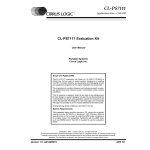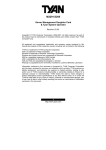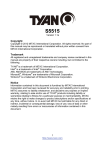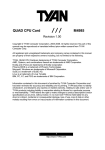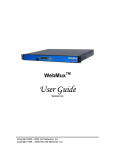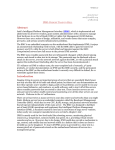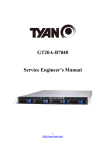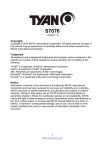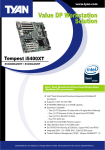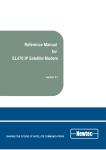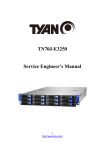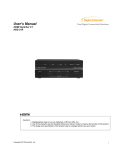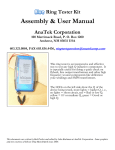Download Server Management Daughter Card & Tyan System
Transcript
M3289 Server Management Daughter Card & Tyan System Operator Revision v1.04 Copyright © TYAN Computer Corporation, 2004-2005. All rights reserved. No part of this manual may be reproduced or translated without prior written consent from TYAN Computer Corp. All registered and unregistered trademarks and company names contained in this manual are property of their respective owners including, but not limited to the following: TYAN is a trademark of TYAN Computer Corporation Intel is a trademark of Intel Corporation QLogic, Zircon, and combinations thereof are trademarks of QLogic Corporation Windows and HyperTerminal are a trademark of Microsoft Corporation ARM is a registered trademark of ARM Limited JDK is copyrighted by Sun Microsystems, Inc. ACE and TAO are copyrighted by Douglas C. Schmidt Winpcap is copyrighted by the University of California, Lawrence Berkeley Laboratory Information contained in this document is furnished by TYAN Computer Corporation and has been reviewed for accuracy and reliability prior to printing. TYAN assumes no liability whatsoever, and disclaims any express or implied warranty, relating to sale and/or use of TYAN products including liability or warranties relating to fitness for a particular purpose or merchantability. TYAN retains the right to make changes to product descriptions and/or specifications at any time without notice. In no event will TYAN be held liable for any direct or indirect, incidental or consequential damage, loss of use, loss of data or other malady resulting from errors or inaccuracies of information contained in this document. 1 http://www.tyan.com Table of Contents Box Contents About this Manual Chapter 1: Overview 1.1 What are SMDC and TSO? 1.2 Features of Tyan Server Management 1.3 How SMDC and TSO work 1.4 Operating System Compatibility Page 3 Page 4 Page 5 Page 5 Page 6 Page 6 Chapter 2: Hardware Information 2.1 What is SMDC 2.2 Card Image 2.3 Card Layout 2.4 Jumper Setting 2.5 Card Features 2.6 Card Installation Page 7 Page 8 Page 9 Page 9 Page 11 Page 14 Chapter 3: Software Information What is TSO 3.1 3.1.1 Three Components 3.1.2 Four Software Parts TSO Connection Models 3.2 3.2.1 Simple Intranet Model-1 3.2.2 Simple Intranet Model-2 3.2.3 Simple Intranet Model-3 3.2.4 Complex Intranet Model 3.3 TSO Access Model 3.4 Features Pre-setup and Installation 3.5 3.5.1 Pre-setup 3.5.2 Installation TSO Access 3.6 3.6.1 In-Band Access 3.6.2 Out-of-Band Access 3.6.3 Discovery Setting Page 18 Page 18 Page 18 Page 20 Page 20 Page 21 Page 21 Page 22 Page 23 Page 24 Page 25 Page 25 Page 26 Page 29 Page 29 Page 31 Page 35 Chapter 4: Troubleshooting Technical Support 2 http://www.tyan.com Box Contents The retail motherboard package should contain the following: 1 x TYAN System Management Daughter Card 1x 50-pin Ribbon Cable 1 x Serial-to-Serial Cable 1 x Standard PCI Bracket 1 x Low Profile PCI Bracket 1 x HD Bay Bracket (Option) 1 x SMDC & TSO User’s Manual 1 x TYAN TSO CD If any of these items are missing, please contact your vendor/dealer for replacement before continuing with the installation process. 3 http://www.tyan.com About this Manual This manual is designed to provide the basic information for the SMDC M3289. It includes the introduction of hardware, software and general troubleshooting procedures. Chapter 1: Overview – Includes the basic introduction of SMDC, TSO and Server Management. Chapter 2: Hardware Information – Introduces the hardware information, including card features, specification, components, jumper setting and installation procedure. Chapter 3: Software Information – Introduces the software information of TSO (Tyan System Operator), including features and how SMDC and TSO work. Chapter 4: Troubleshooting – Provides the general troubleshooting procedures the users will meet in their daily work, effectively reducing the problems happened in the process of server management. 4 http://www.tyan.com Chapter 1: Overview Servers today provide the necessary resource for corporate databases, financial and statistical analysis data, military defense networks, and much more. To act as the heart and soul of any network, servers must be infallible or near infallible. There must be competent management of IT resources at all times in order to keep servers and networks running smoothly and without incident. However, most network and server administration staff can just provide part of that support, they cannot be present 24 hours a day, 7 days a week, on a constant 365-day calendar. To help provide a solution for constant vigilance, the server remote management card eliminates the problem of having an administrator on call at all times. Tyan has the entire package to manage servers and networks. This makes the Tyan solution one of the most complete IT resource tools available. 1.1 What are SMDC and TSO? SMDC stands for Server Management Daughter Card while TSO stands for Tyan System Operator. The TSO is software made by Tyan which acts as a front end client for Windows and provides additional functionality to SMDC. The SMDC and TSO offer remote management over servers. The remote management gives the ability to monitor and control remote resources, such as temperature monitoring, fan control, turning system on/off, or modifying system settings remotely. 1.2 Features of Tyan Server Management Monitor various system components remotely - such as fans, processor temperature, and more Remote power on and power off Console redirect -the ability to view system remotely Alert and error actions -such as audible beep, e-mail, power down and reboot SMDC runs on stand-by power -the SMDC will continue to function, even if the system is not powered on 5 http://www.tyan.com 1.3 How SMDC and TSO work The brief descriptions below will help explain how these items function. For further, more in-depth descriptions, please refer to Chapter 3: Software information. Agent – a system with SMDC installed The SMDC is installed in the Agent system that uses a compatible/supported Tyan motherboard. Manager – manages the Agent The Manger is set up to manage the Agent that has the SMDC. The Manager and Agent should be located in the same place. Console – communicates with Manager The Console is used to monitor and control the Agent through the Manager. 1.4 Operating System Compatibility The remote management is compatible with the following operation systems: Microsoft® Windows® 2000 Windows® XP Red Hat® RH Linux 7.2 – 9.0, Server2.1-3.0 (WS & AS, 32- bit & 64-bit) SuSE® SuSE Server 8.0, 9.0, Professional 9.0, 9.1(32/64-bit) 6 http://www.tyan.com Chapter 2: Hardware Information 2.1 What is SMDC The Tyan Server Management Daughter Card (SMDC) is a powerful, yet cost-efficient, solution for high-end server management hardware packages. The SMDC provides remote system monitoring and control even when the operating system is absent or fails, and empowers server boards with advanced industry standard features. It effectively enables IT Managers to have remote and multi-interface access to monitor, control, and diagnosing activities. The SMDC is powered by an intelligent controller known as the Baseboard Management Control (BMC). The BMC is a standalone mini-CPU that runs on its own Real Time Operating System (RTOS) to complete a variety of tasks. Backed by QLogic’s reliable ARM7 technology, systems are consistently monitored and supported. Unlike regular cards such as AGP cards, network cards or SCSI cards, the SMDC is not a peripheral card that requires any hardware specific driver. As long as standby power supports the system, the SMDC will monitor the system. The Tyan SMDC provides many diverse methods to communicate with the hardware. There is flexibility to choose among Keyboard Controller Style (KCS), Block Transfer (BT) style, Intelligent Chassis Management Bus (ICMB), Intelligent Platform Management Bus (IPMB), Emergency Management Port (EMP) and standard IPMIOver-LAN communication as defined in latest IPMI 1.5 specification. The Tyan SMDC is compatible with all IPMI-compliant software as well as with the Tyan System Operator™ (TSO) software package. The SMDC hardware is OS-dependent and is fully compatible with all major Operating Systems. 7 http://www.tyan.com General Features of SMDC Feature BMC IPMI FRU SDR SEL GPIO IPMB EMP ICMB RTC IPMI-Over-LAN Remote Host Control Remote Sensor Monitor Remote Diagnostic BMC Firmware Update ASF TSO Description QLogic Zircon V2 based on ARM7 technology Version 1.5 Spec “Field Replaceable Unit” Information Storage Sensor Data Record Sensor Event Log “General Purpose Input and Output” lines for future expansion. Intelligent Platform Management Bus Emergency Management Port Intelligent Chassis Management Bus Real Time Clock Remote sensor monitor, host control and system diagnose Power up, down, reset, power cycle or NMI through LAN port SMDC provides sensor information as long as BMC receives enough operating power. SMDC allows for system diagnostic when the system is not in operation (both intentionally or accidentally) through remote IPMI command execution. SMDC supports onboard update of the BMC firmware. Alert Standard Forum Tyan System Operator ™ 2.2 Card Image 8 http://www.tyan.com 2.3 Card Layout 2.4 Jumper Setting Label J1 Header Type/Part HDR25X2_SVM_A Description SVM Edge Connector A J2 CHS_LED Reserved for debug J8 HDR2 Back up power input J9 HEADER7X2 JTAG J10 HDR2 SMDC Hard Reset J11 HDR2 I2C Bus #1 Connector HDR5X2 UART / Emergency Management Port (Pin5 GND type) HDR4 SMDC Private I2C Bus Connector/LCD Extension Port (ZS Bus #3) J28 J41 9 http://www.tyan.com Pin Layout Reserved Pin 1 Pin 2 Pin 1 Pin 2 Pin 1 Pin 2 Pin 3 Pin 1 Pin 2 Pin 3 Pin 4 Pin 5 Pin 6 Pin 7 Pin 8 Pin 9 Pin 10 Pin 1 Pin 2 Pin 3 Pin 4 GND 5V input Reserved GND BMC_RESET# SCL GND SDA DCD RXD TXD No Connection GND No Connection RTS CTS RI No Connection SDA GND SCL 5VSB out J45 HDR2 Test Jumper (ZGPIO23/ZLRST# Jumper) Default: CLOSED J46 HDR5X2 Serial Console Input (Pin-5-GND type) J47 HDR5X2 Serial Console Input (Pin-9-GND type) 10 http://www.tyan.com Pin 1 Reserved Pin 2 Reserved Pin 1 Pin 2 Pin 3 Pin 4 Pin 5 Pin 6 Pin 7 Pin 8 Pin 9 Pin 10 Pin 1 Pin 2 Pin 3 Pin 4 Pin 5 Pin 6 Pin 7 Pin 8 Pin 9 Pin 10 DCD RXD TXD DTR GND DSR RTS CTS RI No Connection DCD DSR RXD RTS TXD CTS DTR RI GND No Connection 2.5 Card Features The SMDC M3289 is equipped with the following features: Hardware Monitoring Protocol and Standard Auxiliary Communication Interface 2 Auxiliary SMBus / I C buses Teamed with other IPMB Devices (PMCs and EMCs) Remote Monitor, Control and Diagnostics Remote Console Redirect over LAN Sensor Data Record System Event Log Field Replaceable Unit Information Storage Real Time Clock Upgrade BMC firmware “Always Ready” TYAN System Operator ™ (TSO) OEM Drivers Front Panel LED and Buzzer (Optional) Hardware Monitoring The latest hardware from TYAN is equipped with Baseboard Management Controller (BMC) from QLogic Zircon which provides not only system monitoring but also remote manageability. The BMC can always monitor the hardware regardless of how the operating system is running. With the BMC onboard, any IPMI-compliant software can monitor, control or diagnose the hardware locally, or from a remote site. Protocol and Standard • Intelligent Platform Management Interface (IPMI) • Remote Management and Control Protocol (RMCP) for IPMI-Over-LAN • Alert Standard Forum (ASF) Auxiliary Communication Interface (Other standard devices that the SMDC communicates with) • IPMB = Intelligent Platform Management Bus • LAN = Local Area Network Auxiliary SMBus / I2C buses The SMDC provides 4 dedicated and independent buses for user expansion. Many devices including Northbridge, Southbridge, Super I/O, Hardware Monitor, LAN 2 2 controller, etc., provide I C communication. These I C buses bridge the proper communication between these devices. Teamed with other IPMB Devices (PMCs and EMCs) Numerous devices in the market already support IPMB communication. BMC facilitates the control and management of these devices. PMC stands for Peripheral Management Controller and EMC stands for Enclosure Management Controller. 11 http://www.tyan.com Depending on the overall set up of the system, the SMDC could initialize and communicate with other PMC/EMC residing on the same IPMB bus. Simply connect the devices to the designated IPMB connector. Available PMC/EMC options include: • Satellite controller - SCSI RAID controller unit • Power supply - power supply unit that has a hardware monitoring chip inside Remote Monitor, Control and Diagnostics Sensor Monitor • Voltage • Temperature • Tachometers • Fan Speed Control / PWM • Chassis Intrusion Control Command Set • Power Up • Power Down • System Reset • System Power cycle • System NMI • Watchdog Timer Diagnostic Command Set • Power-Good Detection • CPU Voltage Identification (CPU VID) • ACPI State Detection • Request Message Redirection through IPMB and ICMB • Remote Console Redirection over LAN Remote Console Redirect over LAN Remote Console Redirection allows IT managers to effectively control and maneuver text console of a remote machine. Serial console information goes through the M3289 SMDC and is processed over the network. TSO software then reproduces the exact text console at a remote location. For example, someone may own a group of servers at a remote location and could change options of those servers from a completely separate location. Another example is that one may log in to the Linux serial console through M3289 SMDC over the network. See SMDC installation section for details. Sensor Data Record (SDR) Each sensor has its own corresponding characteristics. They are built according to IPMI standard to provide users the most information possible about a sensor. Details such as measuring units and calibration factors are available while they are not provided in traditional hardware monitoring systems. SDR is specific to motherboard. Tyan provides a utility to easily upgrade the BMC firmware to support each motherboard model. System Event Log (SEL) A complete history of system events such as POST events are stored and secured in non-volatile memory. Critical events within the server detected by the BMC are 12 http://www.tyan.com recorded in the SEL. Certain pre-programmed actions may take place such as system reboot or system shutdown. Field Replaceable Unit Information Storage (FRU) Chassis, Board, Product and other important service information are stored and secured in an area generally known as FRU. Real Time Clock (RTC) SMDC maintains its own RTC for scheduling events and keeps it in sync with system RTC. Upgrade BMC Firmware The BMC supports Firmware Flash through IPMI firmware commands. The Firmware is stored in boot block flash part. The boot block section code is normally programmed infactory and it provides protection against accidental flash failure or power loss. BMC Firmware may be upgraded from a remote console running Tyan System Operator (TSO). See TSO section for details. “Always Ready” SMDC runs on stand-by power; all monitoring and alerting operations of BMC can begin full operation by using only standby power. Tyan System Operator ™ (TSO) TSO is a software tool created specifically for IPMI-compliant systems with SMDC. It intends to provide IT managers the ability to monitor, control and diagnose their Tyan server boards with ease and flexibility in a remote configuration. See Chapter 3: Software Information for further details. OEM Drivers Tyan may provide driver support for other third party software at request. Contact your Tyan support representative for more details. Front Panel LED and Buzzer (Optional) In additional to standard BMC functionalities, BMC firmware may control Front Panel LED and motherboard Buzzer for error warning and display. 13 http://www.tyan.com 2.6 Card Installation Before you begin, please take the following precautions: (1) Ground yourself properly before removing the SMDC from the antistatic bag. Unplug the power cord from your computer power supply and then touch a safely grounded object to release static charge (i.e. power supply case). For the safest conditions, TYAN recommends wearing a static safety wrist strap. (2) Hold the SMDC by its edges and do not touch the bottom of the card. (3) Avoid touching the SMDC components such as IC chips or connectors. (4) Place the SMDC on a grounded antistatic surface or on the antistatic bag that the board was shipped in. (5) Inspect the card for damage. Note: This installation guide assumes that the user has already completed installing their motherboard and chassis. You can install the SMDC card to your motherboard in three easy steps. Make sure your system is powered off first. Step 1: Find the dedicated location to mount the SMDC. There are four possible ways to mount the SMDC card. 1. Full-size PCI bracket mounting solution 2. Half-size PCI bracket mounting solution 14 http://www.tyan.com 3. Direct mounting to TYAN Chassis solution 4. Hard Driver size bracket mounting solution Step 2: Connect 2x25 ribbon cable between Tyan motherboard SMDC connector and Tyan SMDC J1. Make sure that the key on the ribbon cable aligns with the key on the connector, and that the red line on the ribbon aligns with pin 1 of the connector. 15 http://www.tyan.com Step 3: Connect 2x5 ribbon cable between Tyan motherboard COM2 connector and Tyan SMDC J46 or J47. (Check with www.tyan.com SMDC FAQ for J46/J47 connector) Make sure that the key on the ribbon cable aligns with the key on the connector, and that the red line on the ribbon aligns with pin 1 of the connector. Step 4: Locate the onboard “SMDC-Link” Network Interface Controller (NIC) on Tyan motherboard. (Check with www.tyan.com SMDC FAQ for SMDC-Link NIC location) 16 http://www.tyan.com Step 5: Verify/flash Tyan motherboard system BIOS with the SMDC support (Check with www.tyan.com SMDC FAQ for download information) The SMDC support system BIOS will display “SMDC detected” and setup serial console redirection automatically. Users will see the serial console redirection setting is at “SMDC”. The “SMDC” serial console redirection setting is as below. • Remote Access Serial • Serial Port Number COM2 • Serial Port Mode 19200 • Terminal Type VT100 Step 6: Verify/Flash/Setup SMDC firmware version (Check with www.tyan.com SMDC FAQ for download information) Boot the system to DOS and run “util.exe” which comes with TSO software CD to find out about firmware version. Make sure the firmware version matching with the Tyan motherboard model and update to the latest as possible. 17 http://www.tyan.com Chapter 3: Software Information Tyan System Operator (TSO) is an IPMI-aware management tool for systems based on TYAN motherboards. Through TSO, Users have an easier way to remotely access system health information, do system maintenance and make the running systems much safer. 3.1 What is TSO 3.1.1 Three Components The specially designed software TSO (Tyan System Operator) includes three components: z z z TSO MANAGER TSO AGENT TSO CONSOLE TSO supports the following operating system: Windows 2000, Windows XP Pro (32-bit) and Windows Server 2003 (32-bit) RedHat 7.2, 7.3, 8.0 and 9.0, Server 2.1 and 3.0 (32-bit & 64-bit) SuSE Server 8.0, 9.0, Professional 9.0, 9.1 and 9.2 (32-bit & 64-bit) MANAGER MANAGER is the core component of TSO. It provides communication between CONSOLE and AGENT. MANAGER is normally installed at the gateway or proxy machine in the subnet AGENT AGENT runs on a target system which is to be managed. AGENT is normally installed at a data-server or email-server machines CONSOLE CONSOLE provides GUI (Graphic User Interface) for an administrator to perform all management functions. 3.1.2 Four Software Parts TSO includes four software parts: Management Console, Authentication Service, Server Agent and System Monitor. The four parts and their function descriptions are as following: Management Console Provide integrated one-to-many user interface to do remote server management. (OS supported: Windows XP Pro (32-bit)) z Implement Microsoft Management Console (MMC) 2.0 interface 18 http://www.tyan.com System Monitor Provide one-to-one user interface to do remote server management. (OS supported: minimum of Windows 2000 or later) Notes: Currently the System Monitor only supports the Server Agent which runs on Windows platform. Please refer to the User Guide for System Monitor. Authentication Service Core part of the TSO. It provides communication between Management Console and Server Agent, specifically for the action request. Browsing request can be made directly through SNMP from Management Console to Server Agent. (OS supported: minimum of Windows 2000 or later) z User Authentication Authenticates the user who logged in by Management Console and verified corresponding privileges for the servers registered in the TSO Authentication Service. z User Management Administrator can manage user accounts on the Authentication Service through Management Console. Such as adding users, deleting users, modify users and etc z Server Management Group servers that have been registered on the TSO Authentication Service. z Server Status Notification Notify the logged users the status change of the servers, such as server on/down and so on. z Action Authentication Authenticate the action request from Management Console according the login user’s privilege. Server Agent Agent runs on that system which is to be managed. (OS supported: minimum of Windows 2000 or later, Red Hat 7.2) z IPMI view Provides the ability to browse the IPMI data through SNMP, including FRU, SDR, Sensor Reading, and SEL, compatible with IPMI standard. z Action requested from Management Console: ¾ Gracefully power control (power down, reboot and wake-on-LAN). ¾ Hard power control (power on, power down, power cycle and reboot). ¾ Firmware flash (BIOS flash and BMC firmware flash) z Error action Allows error action, such as beep, email, power down and reboot, when sensor reading is abnormal, according to user’s settings. 19 http://www.tyan.com TSO running model can be described as follows: Management Console Authentication Service Server Agent Server Agent Server Agent System Monitor System Monitor System Monitor 3.2 TSO Connection Models 3.2.1 Simple Intranet Model-1 z z TSO MANAGER and CONSOLE can be loaded onto the same system TSO AGENT can only work over Tyan server motherboards (Check www.tyan.com TSO FAQ) 20 http://www.tyan.com 3.2.2 Simple Intranet Model-2 z z TSO MANAGER and CONSOLE can be loaded onto two separate systems TSO AGENT can only work over Tyan server motherboards (Check www.tyan.com TSO FAQ) 3.2.3 Simple Internet Model-3 z z TSO MANAGER and CONSOLE can be loaded onto two separate systems TSO AGENT can only work over Tyan server motherboards 21 http://www.tyan.com 3.2.4 Complex Internet Model z z z TSO MANAGER and CONSOLE can be loaded onto separate systems TSO AGENT can only work over Tyan server motherboards (Check www.tyan.com TSO FAQ) All TSO CONSOLE systems can log in different MANAGER to read/control AGENT systems 22 http://www.tyan.com 3.3 TSO Access Model z z z z z z In-Band ¾ MANAGER talks to AGENT system through the OS and AGENT services ¾ In-band can only function when the OS and AGENT services are running Out-Of-Band ¾ MANAGER talks to AGENT system through the BMC chip of the SMDC ¾ Out-of-band can function with or without the OS and Agent services. Access Authentication ¾ MANAGER/AGENT/SMDC Authentication In-Band Access CONSOLE needs to (1) pass the MANAGER Authentication and (2) pass the AGENT Authentication to access all In-Band features Out-Of-Band Access CONSOLE needs to (1) pass the MANAGER Authentication and (2) pass the SMDC Authentication to access all Out-OfBand features External-IP and Internal-IP 23 http://www.tyan.com 3.4 Features Remote System Health Monitoring & Alerting Remote monitor system’s health, including voltage, temperature, fan and so on. Log event when error occurs and alert by beeping, emailing administrator, or doing power down/reboot, according to customizable settings. z IPMI related information browsing Browse FRU, SDR, Sensor Reading and SEL. Both raw data and interpreted data are displayable, and selectable by user z Alert action when error occurs According to the user settings, TSO can perform four different alert actions per sensor, including beeping, emailing, power down and reboot. z System status reporting Report system health information in fixed period. Report system power state (On/Off). Report system information source (BMC or Hardware Monitor). z Remote IPMI command execution Remote execute IPMI command according to IPMI specification. Remote System Maintenance z Remote update system BIOS. z Remote update BMC firmware if BMC is available. z Modify SDR information to affect system monitoring and alerting User can modify the event trigged thresholds per sensor and set alert actions per sensor. So as to customize the system’s IPMI settings. z Exporting IPMI related information User can select the IPMI information he/she wants, and export it to format text file, which can be put into other applications to generate reports he/she wants, such as Excel. z Watchdog User can enable the watchdog to doing reboot when OS is dead. z Gracefully system power control Remote power down / reboot the system gracefully. Wake the system on LAN. Hard system power control through IPMI-over-LAN Remote power up/power down/reboot the system through IPMI-over-LAN. BMC must be available. 24 http://www.tyan.com z Server Grouping Servers under monitoring can be grouped according to user’s demands. z Server viewing based on group Servers are organized in different groups. User can do the grouping according to the demands. Security Actions taken on the server are authenticated based on the user privilege. z User account management Add, modify and delete user. Assign privilege to user on the specific server. 3.5 Pre-setup and Installation 3.5.1 Pre-setup Authentication and Privilege TSO provides security access with MANAGER Authentication, Agent Authentication and SMDC Authentication. User needs to prepare the privilege information (user-name and password) for each system in order to access target system. z z No password is prohibited Case sensitive under Linux and Out-of-Band Internal-IP and External-IP TSO requires Internal-IP and External-IP setup by user during the TSO installation. User needs to make sure the IP matching with Network Interface Controllers (NIC). z Configuration I If CONSOLE is often being used outside of the subnet in which all/some machines are equipped with SMDC, the machine that runs MANAGER would have 2 NIC’s. MANAGER will likely be installed at the gateway or proxy machine in the subnet. ¾ ¾ z Configure Internal IP to be a valid IP under this subnet. This subnet is typically known as a Local Area Network (LAN). The IP would look like this for example: 192.168.1.1, 192.168.1.254 Configure External IP to be a valid IP under the main network. This main network is typically known as a Wide Area Network (WAN). This IP would be a ‘true’ IP, meaning it is the one and only one among all the machines in the world. The IP would look like this for example: 206.13.28.12, 216.239.53.99 Configuration II If CONSOLE is being used inside the same subnet, the machine that runs Manager may have only 1 NIC. MANAGER can be located on any machine in the network. Notice that MANAGER and CONSOLE need not be installed on the same machine even though they can/may be install on the same machine. 25 http://www.tyan.com ¾ ¾ z Configure Internal IP to be a valid IP under this subnet. Configure External IP to be the same as Internal IP. Firewall Firewall setup information: TSO MANAGER and CONSOLE will use the following 4 ports for firewall setup. ¾ 20010 : tcp ¾ 20040 : udp ¾ 20060 : upd ¾ 21020 : tcp For RedHat Firewall (IPTABLES) Setup 1. Type "setup" to execute the setup utility 2. Select "Firewall Configuration" 3. Select "Customize" 4. Select "Other Ports" 5. Type "20010:tcp, 20040:upd, 20060:udp, 21020:tcp" 6. Select "OK 3.5.2 Installation z Installation Procedures under Linux System (via KDE or Gnome GUI Interface) Put the TSO CD into the CD-ROM drive. You will see a TSO CD-ROM icon on the screen. 1. Click on TSO CD-ROM 2. Click on the menu “install.sh” 3. You will see the screen of “Run or Display”. Choose and click “Run in Terminal”. You will see the screen with four choices: TSO Agent/TSO Manager/TSO Console/Exit. Type the number you want to install. Agent: - Select one of network interfaces to bundle (0 or MAC). - Press Enter to complete installation. Manager: - Select one of external network interface to bundle. - Press Enter to complete installation. Console: - Select one of external network interfaces to bundle. - Press Enter to complete installation. 4. After finishing the installation, type Exit to leave the screen. 26 http://www.tyan.com z Installation Procedures under Windows System Agent 1. Put the TSO CD in the CD-ROM drive. 2. Click on the “TSO” item. Select “TSO Server Agent”. 3. Click on “Next” to start the installation procedure. 4. Indicate the Server Agent’s computer name. 5. A License Agreement menu will pop up. Click “Yes”. 6. Click on “Next” after confirming the use of destination directory. 7. Click on “Next” to confirm the setting. 8. Click on “Finish” to finish the installation. Manager 1. Insert TSO CD into CD-ROM drive. Select “TSO”. 2. Double click “TSO Manager”. 3. Double click “INSTALL SUN JDK1.4J_02”. 4. You will see a Welcome menu. Click “Next”. 5. A License Agreement menu will pop up. Click “Yes”. 6. After confirming the destination location of software, click “Next”. 7. Select all the components and then click “Next”. 8. The software will link with IE. Click “Next”. 9. Click “Finish” to finish “Javk2 SDK installation. 10. Go back to TSO manager installation menu. Select “INSTALL WINPCAP”. 11. Installation Wizard will show up. Click “Next”. 12. Click “Next” if you agree with License Agreement. 13. Click “OK” to finish WinPcap 3.0 installation. 14. Go back to TSO manager installation menu. Select “INSTALL TSOManager”. 15. A welcome message will pop up. Click “Next”. 16. Click “Yes” if you agree with the TSO License Agreement. 17. After filling in user and company names, click “Next”. 18. Click “Next” after confirming the destination location of software. 19. Click “Yes” to reboot the system to initiate TSO Manager. 20. Click “Finish” to finish the TSO manager installation. Console 1. Put “TSO” CD into CD-ROM drive. Click “TSO Console”. 2. Click on “INSTALL SUN JDK 1.4J_02”. 3. A Welcome message will appear. Click “Next”. 4. A License Agreement menu will show up. Click “Yes”. 5. After confirming the destination location of software, click “Next”. 6. Select all the components and then click “Next”. 7. The software will link with IE. Then click “Next”. 8. Click “Finish” to finish Javk2 SDK installation. 9. Go back to “INSTALL TSO CONSOLE” menu. Select “INSTALL TSO Console”. 10. A Welcome Message will pop up. Click “Next”. 11. A License Agreement menu will show up. Click “Yes”. 27 http://www.tyan.com 12. After typing user and company names, click “Next”. 13. After confirming the destination location of software, click “Next”. 14. Choose the match LAN port IP and MAC for SMDC cards. Then click “Next”. 15. Click “Finish” to finish TSO Console installation. 28 http://www.tyan.com 3.6 TSO Access TSO provides two ways (In-Band and Out-Of-Band) for reading and controlling AGENT systems. 3.6.1 In-Band Access • Log in MANAGER o Log in MANAGER from CONSOLE with the privilege ID, user name and password • Log in AGENT o Highlight the IP of the target system (Under In-Band) o Log in AGENT of the target system with the privilege ID and password • System Event Panel o Click “System Event Panel” to read all event log of the target system o “Clear” Icon Click the icon to clear system event log 29 http://www.tyan.com • Sensor Reading Panel o Click “Sensor Reading Panel” to read all sensor data record of the target system o “Notification Setting” Icon - Highlight any row in the SDR window - Click the icon to set Sensor Threshold o “Properties” Icon - Highlight any row in the SDR window - Click the icon to set Sensor Alert Action o Sensor Threshold - Make changes to lower and upper thresholds here o Sensor Alert Action - Check the desired alert method o Notification Configuration - Input a valid e-mail address - Input a valid SMTP server - Email information will be used if email event action is desired 30 http://www.tyan.com • Power Management Panel o Click “Power Management Panel” to access all In-Band power management features of the target system o “Power Off” Icon - Click the icon to have the target system do graceful shutdown o “Reboot” Icon - Click the icon to have the target system do graceful reboot o “Update BIOS” Icon - Click the icon to flash the system BIOS of the target system o “Update BMC Firmware” Icon - Click the icon to flash the SMDC BMC firmware of the target system 3.6.2 • Out-Of-Band Access Login MANAGER o Log in MANAGER from CONSOLE with the privilege ID, user name and password • Login SMDC MANAGER o Highlight the IP of the target system (Under Out-Of-Band) o Log in SMDC with the privilege ID and password o Privilege Names: Administrator, User, Callback, and Operator (case sensitive) 31 http://www.tyan.com • Power Management Panel o Click “Power Management Panel” to access all Out-of-Band power management features of the target system o “Refresh” Icon - Click the icon to instantly update SMDC Information “Power Down” Icon - Click the icon to hard shutdown the target system o “Power UP” Icon - Click the icon to power up the target system “Power UP” Icon with “Boot to BIOS” checked - Click the “Power UP” icon with “Boot to BIOS” checked to get into the target system BIOS setup when system is powered up o “Power Cycle” Icon - Click the icon to power cycle the target system (Target system would power down for a few seconds then power up) o “Reset” Icon - Click the icon to reset the target system o “Reset” Icon + “Boot to BIOS” checked - Click the icon with “Boot to BIOS” checked to get into target system BIOS after system is reset o “Cold Reset” Icon - Click the icon to cold reset SMDC o “Warm Reset” Icon - Click the icon to warm reset SMDC 32 http://www.tyan.com • Sensor Reading Panel o Click “Sensor Reading Panel” to read all sensor data record of the target system - The first access of sensor reading will take about one minute and all readings will be updated about every 15 seconds • System Event Panel o Click “System Event Panel” to read all event log of the target system - The first access of system event reading will take about one minute and all system events will be updated about every 15 seconds o “Refresh” Icon Click the icon to refresh system event log o “Clear” Icon Click the icon to clear system event log 33 http://www.tyan.com • BMC Panel o Click “BMC Panel” to read all BMC LAN configurations of the target system o “Refresh” Icon - Click the icon to review IP Address, MAC Address and Subnet Mask o “Update” Icon - Make all desired changes about IP Address, MAC Address and Subnet Mask - Click the icon to update new values into SMDC • User Panel o Click “User Panel” to access SMDC privilege of the target system o “Refresh” Icon - Click the icon to review available users o “User Name” Bar/Drag Down - Click the button and scroll to the desired user o “Privilege” Field - Review privilege for corresponding user o “Change Password” Icon - Click the icon to update password 34 http://www.tyan.com • Console Redirect Panel o Click “Console Redirect Panel” to begin console redirect via LAN feature of the target system o “Start” Icon - Click the icon to start console redirect via LAN feature of the target system o “Stop” Icon - Click the icon can stop console redirect via LAN feature of the target system 3.6.3 Discovery Setting • Discovery setting dialog o Enable or Disable discover BMC or TSO Agent o Set the interval between two discover action o Enable or Disable save the discovered system record on TSO Manager o When OS on the server with BMC is running, Broadcast ASF Ping will be ignore by OS TCP/IP stack, so you need enable the “Scan IP” function to discover the BMC o If you install the TSO Agent on the server with BMC, you also can “Discover the BMC via Agent” when OS is running 35 http://www.tyan.com Chapter 4: Troubleshooting The following provides the general problems and solutions you will meet in setting up the SMDC card. For more information, please visit our website http://www.tyan.com. Question: What are SMDC and TSO? Solution: SMDC means System Management Daughter Card. It’s an embedded system, independent of the operating system, using the Sm bus to monitor hardware sensors. TSO means Tyan System Operator. It is installed on different operating systems and allows remote or local monitoring. Where can I find information about SMDC/TSO on the Tyan Website? You can find a page of information for all related motherboards and SMDC/TSO needs at the following link: http://www.tyan.com/support/html/faq_tso.html Where can I find information about bios versions that are needed for my motherboard so it supports SMDC/TSO correctly? You can find listing of the bios versions for the various motherboards at the following link: ftp://ftp.tyan.com/software/tso/bios/ Where can I find information about firmware versions that are needed for my motherboard so it supports SMDC/TSO correctly? You can find a listing of all the firmware versions at the following link: ftp://ftp.tyan.com/software/tso/firmware/ Where can I find information about utilities that are needed for my motherboard so it supports SMDC/TSO correctly? You can find the utilities at the following link: ftp://ftp.tyan.com/software/tso/utility/ Where can I find information about utilities that are needed for my motherboard so it supports TSO correctly? You can find the TSO software at the following link: ftp://ftp.tyan.com/software/tso/tso/ Where can I find the link to the manual? You can find the manual at the following link: ftp://ftp.tyan.com/software/tso/m_m3289_103.pdf Question: Does your SMDC support OpenIPMI? Solution: Yes. However the APR function is initially disabled. Using the util.exe program you can enable this function. Only the firmware revisions above 1.72 build 1722 support the APR functionality. Question: Do you provide a 64-bit version of the TSO Agent? Solution: Yes, currently we support the 64-bit version for SuSE Enterprise 8 and Professional for AMD64 bit. Question: Can I remotely set IP address to SMDC? Solution: Yes. By highlighting (selecting) this node and logging into the SMDC card you can remotely change the IP address in the menu “console tool/modify server”. 36 http://www.tyan.com Question: Why can I not discover the SMDC card? Solution: There may be many reasons why the SMDC card is not located: z Check the SMDC light. Make sure that when the computer is on it is in “power on” status (light continually on and not flashing). This assures that the SMDC firmware is functioning properly. When the computer is off the light should be flashing. If it is not flashing, you may need to reset the comes (2 pins next to the battery). z Use Util.exe in DOS mode to check IP and MAC address. Make sure they are set correctly on the SMDC card. z Check the setting of “discovery” in Console tool menu. Assure that the IP addresses are within the range indicated. Also make sure this function is enabled. z Use Util.exe in DOS mode to assure that the firmware version and board model are correct. If you do not have the correct firmware you may need to download it from the TYAN SMDC ftp site. z Make sure the correct SMDC firmware for the Broadcom Lan chip is flashed. Also assure you are using the correct NIC port which is supported for this board. Read “Readme” first and also use Util.exe to enable ARP broadcast. Question: Does SMDC support the ARP protocol? Solution: Yes, SMDC supports the Gratuitous ARP and broadcasts the ARP package periodically. To reduce the junk package on LAN, we disable it as default setting. However, users can use Util.exe to enable or disable it. Firmware above revision 1.72 and Util.exe above build 172 support this function. Question: What are the password and user name for protected SMDC firmware? Solution: For out of Band –As specified by IPMI there are 4 security accounts: “Operator, Administrator, Callback, User and Null (blank)”. Use Util.exe to set this password. You can change this password using the remote console function ‘Change Password’. The username and password are case-sensitive. For in band –Log into the monitored system using a valid username and password as required by the respective operating system. Question: How can I use SMDC function before OS is installed and running? Solution: Follow the steps below: 1. Connect the AC power. 2. Boot the system into BIOS and shutdown the BIOS – this step only need to be done once after one SMDC is installed in the mainboard, and SMDC needs the information of MAC address from mainboard. 3. Install the TSO manager and TSO console correctly in client machine. 4. Start TSO console and use Tool/Discovery setting to make sure the SMDC discovery is enabled (including broadcast discovery). 5. All systems with SMDC installed will show up. Correctly set the IP address. 6. Now you can use the Power/Off and other SMDC functions 37 http://www.tyan.com Question: What Linux OS does TSO support? Solution: TSO agent supports the following Linux: NOTE: TSO console and manager is based on JAVA design, so it can only be used on 32-bit Linux distributions. RedHat 7.2 - 9.0, Server 2.1-3.0 (WS & AS, 32-bit & 64-bit), SuSE Server 8.0, Professional 9.0 & 9.1 RedHat 7.2 - 9.0, Server2.1-3.0 (WS & AS, 32-bit) SuSE Server 8.0, Professional 9.0 New 1117 TSO will support Linux 64-bit and has been tested in RedHat AS3.0 and SuSE Server 9 and Pro 9.1. 38 http://www.tyan.com Technical Support If a problem arises with your system, you should first turn to your dealer for direct support. Your system has most likely been configured or designed by them and they should have the best idea of what hardware and software your system contains. Hence, they should be of the most assistance for you. Furthermore, if you purchased your system from a dealer near you, take the system to them directly to have it serviced instead of attempting to do so yourself (which can have expensive consequences). If these options are not available for you then Tyan Computer Corporation can help. Besides designing innovative and quality products for over a decade, Tyan has continuously offered customers service beyond their expectations. Tyan's website (www.tyan.com) provides easy-to-access resources such as in-depth Linux Online Support sections with downloadable Linux drivers and comprehensive compatibility reports for chassis, memory and much more. With all these convenient resources just a few keystrokes away, users can easily find the latest software and operating system components to keep their systems running as powerful and productive as possible. Tyan also ranks high for its commitment to fast and friendly customer support through email. By offering plenty of options for users, Tyan serves multiple market segments with the industry's most competitive services to support them. "Tyan's tech support is some of the most impressive we've seen, with great response time and exceptional organization in general" - Anandtech.com Please feel free to contact us directly for this service at [email protected] Help Resources: 1. See the beep codes section of this manual. 2. See the TYAN website for FAQ’s, bulletins, driver updates, and other information: http://www.tyan.com 3. Contact your dealer for help BEFORE calling TYAN. 4. Check the TYAN user group: alt.comp.periphs.mainboard.TYAN Returning Merchandise for Service During the warranty period, contact your distributor or system vendor FIRST for any product problems. This warranty only covers normal customer use and does not cover damages incurred during shipping or failure due to the alteration, misuse, abuse, or improper maintenance of products. NOTE: A receipt or copy of your invoice marked with the date of purchase is required before any warranty service can be rendered. You may obtain service by calling the manufacturer for a Return Merchandise Authorization (RMA) number. The RMA number should be prominently displayed on the outside of the shipping carton and the package should be mailed prepaid. TYAN will pay to have the board shipped back to you. 39 http://www.tyan.com Notice for the USA Compliance Information Statement (Declaration of Conformity Procedure) DoC FCC Part 15: This device complies with part 15 of the FCC Rules Operation is subject to the following conditions: 1) 2) This device may not cause harmful interference This device must accept any interference received including interference that may cause undesired operation. If this equipment does cause harmful interference to radio or television reception, which can be determined by turning the equipment off and on, the user is encouraged to try one or more of the following measures: • • • • Reorient or relocate the receiving antenna. Increase the separation between the equipment and the receiver. Plug the equipment into an outlet on a circuit different from that of the receiver. Consult the dealer on an experienced radio/television technician for help. Notice for Canada This apparatus complies with the Class B limits for radio interference as specified in the Canadian Department of Communications Radio Interference Regulations. (Cet appareil est conforme aux norms de Classe B d’interference radio tel que specifie par le Ministere Canadien des Communications dans les reglements d’ineteference radio.) Notice for Europe (CE Mark) This product is in conformity with the Council Directive 89/336/EEC, 92/31/EEC (EMC). CAUTION: Lithium battery included with this board. Do not puncture, mutilate, or dispose of battery in fire. Danger of explosion if battery is incorrectly replaced. Replace only with the same or equivalent type recommended by manufacturer. Dispose of used battery according to manufacturer instructions and in accordance with your local regulations. Document #: D1501-104 40 http://www.tyan.com








































